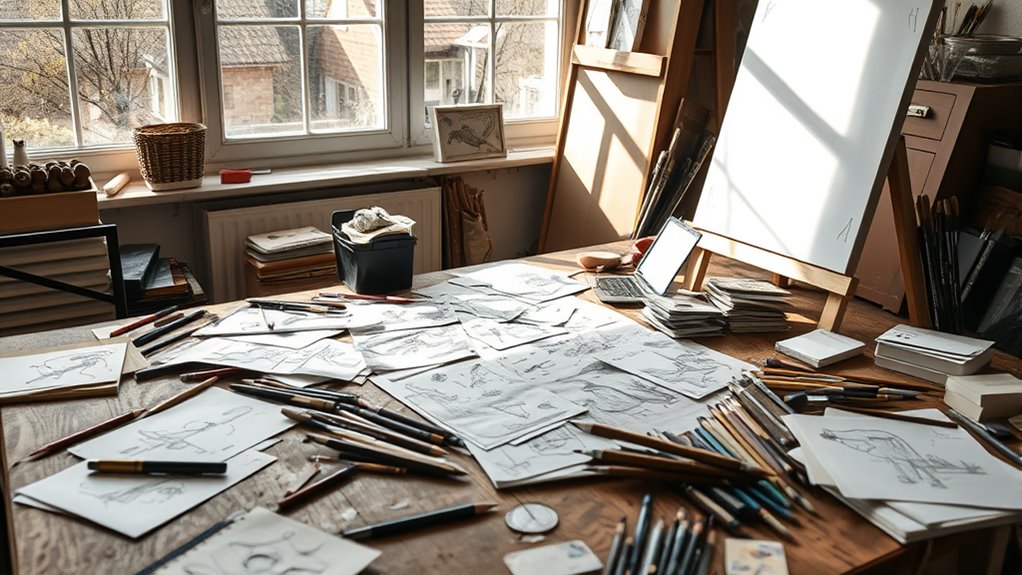The Zeigarnik Effect shows that unfinished creative tasks stay active in your mind, motivating you to return and complete them. This mental tension keeps you engaged and can boost your creative drive, but it may also cause distraction or stress. By managing how you leave tasks unfinished and breaking projects into smaller steps, you can harness this effect for better focus and ongoing momentum. Want to discover how to balance completion and inspiration? Keep going to learn more.
Key Takeaways
- Unfinished creative tasks foster mental tension, increasing motivation to complete and driving ongoing engagement.
- The Zeigarnik Effect heightens focus by creating curiosity and anticipation around incomplete projects.
- Managing unfinished work with strategic stops sustains creative momentum and prevents burnout.
- Breaking projects into smaller segments leverages the Zeigarnik Effect to maintain consistent progress.
- Balancing task completion with periods of incubation enhances inspiration and long-term creative motivation.
Understanding the Psychology Behind the Zeigarnik Effect

The Zeigarnik Effect reveals that your mind tends to remember unfinished tasks more vividly than completed ones. This phenomenon occurs because of cognitive lingerings, where incomplete tasks create persistent memory loops in your brain. When you leave something unfinished, your brain continues to focus on it, generating a mental tug that keeps the task active in your mind. These memory loops make the unfinished work feel more prominent, often causing you to think about it repeatedly. This psychological process explains why incomplete projects stay top of mind, fueling a sense of tension or curiosity. Recognizing the importance of memory loops helps you understand how your brain prioritizes unresolved issues, setting the stage for how the Zeigarnik Effect influences motivation and creative persistence in your efforts.
How Incomplete Tasks Drive Creative Motivation

Incomplete tasks often serve as powerful catalysts for creative motivation because they create a sense of unfinished business that your brain enthusiastically seeks to resolve. This ongoing task anticipation fuels motivation cycles, where your mind continually returns to the unresolved work, pushing you to make progress. As you near completion, motivation intensifies, driven by the desire to close the loop. Conversely, when a task remains incomplete, you experience a subtle tension that keeps you engaged. This persistent mental push encourages you to revisit ideas, refine concepts, and develop solutions. Additionally, understanding the importance of mindfulness can help you manage these drives more effectively, preventing overwhelm and maintaining focus. By leveraging this natural drive, you can stay motivated longer and maintain momentum in your creative projects. Recognizing how incomplete tasks stimulate motivation helps you harness the Zeigarnik Effect effectively, turning unfinished work into a powerful creative force.
Recognizing the Impact of Unfinished Work on Focus and Engagement

When you leave work unfinished, you may notice your mind stays alert, creating a sense of mental tension. This tension often boosts your motivation to complete the task and keeps your creative energy flowing. Recognizing how incomplete work sustains your focus can help you harness this drive intentionally. Additionally, understanding the horsepower of electric dirt bikes can inspire innovative approaches to powering your projects with sustainable energy sources.
Heightened Mental Tension
Unfinished tasks can create a persistent mental tension that disrupts your focus and engagement. This mental tension arises because your mind constantly revisits incomplete work, increasing cognitive load. As your brain endeavors to resolve the unfinished task, it diverts attention from other priorities, making it harder to concentrate. The heightened cognitive load leaves you feeling restless and distracted, reducing your productivity. Instead of fully immersing in new ideas or projects, your mind remains anchored to unresolved issues. This cycle of mental tension keeps you alert but also fatigued, impairing your ability to sustain creative flow. Recognizing this impact allows you to manage unfinished work more effectively, alleviating mental tension and restoring your capacity to stay focused and engaged in your creative efforts. Additionally, understanding how creative projects are affected by the Zeigarnik effect can help in developing strategies to complete tasks more efficiently.
Increased Motivation Levels
Recognizing the impact of unfinished work reveals how it can actually boost your motivation levels. When you leave tasks incomplete, it creates a sense of anticipation and curiosity, encouraging you to stay engaged. This motivation boost stems from your desire to resolve the open loop, making it easier to focus on your work. The Zeigarnik Effect shows that your mind naturally seeks closure, which heightens task engagement. As a result, you’re more likely to invest effort and persist through challenges. Unfinished projects act as subtle reminders, sparking your drive to complete them. Instead of feeling overwhelmed, you experience a compelling urge to finish, fueling your creative energy. This increased motivation can sustain your momentum, helping you make steady progress on your projects. The phenomenon is supported by research on vetted psychological principles that explain why our brains prioritize unresolved tasks.
Sustained Creative Drive
Because your mind naturally seeks closure, leaving projects incomplete can help maintain your focus and engagement over longer periods. The Zeigarnik Effect suggests unfinished work stays active in your mind, encouraging you to return and complete it. Incorporating mindfulness practices helps you stay aware of this drive without becoming overwhelmed, allowing you to channel it productively. During collaborative brainstorming sessions, leaving some ideas open-ended sparks ongoing interest and motivation, as your brain seeks to resolve these unfinished tasks. This sustained creative drive keeps you energized, preventing burnout and fostering continuous progress. Additionally, understanding privacy policies and managing your cookie preferences can help you better control your online experience and maintain focus on your creative work. By intentionally managing unfinished work, you harness your natural tendency to seek closure, ensuring your creative projects stay engaging and dynamic over time.
Strategies to Leverage the Zeigarnik Effect for Creative Boosts

To harness the Zeigarnik Effect, you should break larger tasks into smaller, manageable segments to keep unfinished work in mind. Strategically leaving tasks pending can motivate you to complete them and boost your focus. Consistently making progress, even in small steps, helps maintain momentum and leverages this psychological drive effectively. Additionally, understanding the importance of emotional alignment can enhance your ability to stay motivated and resilient during creative efforts.
Break Tasks Into Segments
Breaking tasks into smaller segments can considerably enhance your creative productivity by leveraging the Zeigarnik Effect. When you use task segmentation, you keep your mind engaged with clear, manageable goals, making it easier to track progress and stay motivated. To effectively implement this strategy:
- Break large projects into specific, actionable steps to create natural stopping points.
- Use progress tracking to monitor completed segments, reinforcing your sense of achievement.
- Tackle tasks one segment at a time, which heightens focus and builds momentum for the next phase.
- Incorporate space and organization techniques to maintain clarity and prevent clutter from hindering your workflow.
This approach taps into your mind’s tendency to remember unfinished tasks, encouraging you to return and complete each segment, thereby boosting overall productivity and creative flow.
Use Pending Tasks Strategically
Strategically managing pending tasks can considerably boost your creative output by tapping into the Zeigarnik Effect. By intentionally leaving certain tasks incomplete, you create mental tension that encourages you to revisit and resolve them. Prioritize tasks based on deadlines and importance to keep the momentum. Use a simple table to visualize this:
| High Priority & Urgent | Low Priority & Non-Urgent |
|---|---|
| Focus on critical tasks | Tackle less urgent tasks later |
| Keep smaller tasks pending | Leave minor details unfinished |
This approach keeps your mind engaged without overwhelming you. You stay motivated, knowing unfinished tasks are subtly nudging you forward. Effective task prioritization and deadline management turn pending tasks into creative catalysts, making sure you stay inspired and productive.
Maintain Consistent Progress
Maintaining steady progress is essential to harnessing the Zeigarnik Effect effectively. When your creative habits include consistent work, unfinished tasks stay active in your mind, motivating you to complete them. To leverage this, focus on project planning that encourages regular momentum. Here are three strategies:
- Break projects into smaller, manageable tasks to ensure frequent progress.
- Set daily or weekly goals to keep your work ongoing and avoid stagnation.
- Schedule dedicated time for creative work, making consistency a routine.
- Incorporate diverse designs and materials to keep your projects engaging and stimulating.
Practical Tips for Managing and Utilizing Pending Tasks

To effectively manage pending tasks and harness the Zeigarnik Effect, you should start by breaking large projects into smaller, manageable segments. This improves task prioritization and enhances your time management. Use a clear system to categorize tasks by urgency and importance, ensuring you focus on high-priority items first. Here’s a simple prioritization framework:
| Urgent | Not Urgent |
|---|---|
| Critical deadlines | Routine tasks |
| Emergencies | Future planning |
| Immediate feedback | Long-term goals |
| Client requests | Personal projects |
| Time-sensitive | Low-impact |
This approach keeps you engaged with unfinished tasks, fueling creativity and progress while preventing overwhelm. Managing pending tasks efficiently helps you stay motivated and makes completing projects feel more achievable.
Balancing Completion and Inspiration in Creative Processes

How can you strike a balance between completing projects and staying inspired? The key lies in managing your creative flow and allowing space for idea incubation. First, set clear milestones to finish projects gradually, preventing overwhelm. Second, dedicate specific times for free exploration without the pressure to complete, fostering inspiration. Third, take breaks to incubate ideas—sometimes stepping away sparks fresh perspectives. By doing this, you maintain momentum while keeping your mind open to new insights. Recognizing when to push forward and when to step back helps prevent burnout and keeps your creative process dynamic. Balancing these elements ensures you stay motivated, productive, and inspired throughout your projects. This harmony allows the Zeigarnik Effect to work in your favor, fueling ongoing creativity.
Frequently Asked Questions
How Does the Zeigarnik Effect Differ Across Various Creative Disciplines?
When exploring how the Zeigarnik Effect varies across creative disciplines, you notice that it influences your focus on unfinished tasks differently. In visual arts, creative tension drives you to complete pieces, while in writing, discipline-specific challenges like writer’s block intensify this effect. Recognizing these differences helps you harness the Zeigarnik Effect, overcoming obstacles and maintaining motivation through persistent engagement with your work’s unresolved aspects in each discipline.
Can the Zeigarnik Effect Cause Creative Burnout or Fatigue?
Like Icarus flying too close to the sun, you might experience creative fatigue or motivation burnout when constantly chasing unfinished ideas. The Zeigarnik Effect can deepen this by making you obsess over incomplete work, draining your energy. While it sparks motivation, overdoing it risks burnout. Recognize when to pause, finish projects, and give yourself space to recharge — balancing obsession with self-care keeps your creativity soaring.
Are There Cultural Differences in How the Zeigarnik Effect Influences Creativity?
You might wonder if cultural differences shape how the Zeigarnik Effect impacts creativity. Cross-cultural perceptions influence how people experience unfinished tasks, affecting creative motivation differently across societies. In some cultures, leaving projects incomplete may boost motivation, while others see it as stressful. Recognizing these variations helps you adapt your approach, harnessing the Zeigarnik Effect to enhance creativity based on cultural context.
What Are Common Misconceptions About the Zeigarnik Effect in Creative Work?
You might think the Zeigarnik Effect guarantees constant inspiration, but that’s a myth. Many believe it’s an oversimplified assumption that unfinished tasks always boost creativity, yet real-world results vary. Misconceptions like these can lead you to overlook other factors essential for creative flow. Recognizing these myths helps you harness the effect more effectively, avoiding false hopes and focusing on genuine strategies that keep your creativity alive and thriving.
How Can Technology Tools Harness the Zeigarnik Effect to Enhance Creativity?
You can harness technology tools by using task management and progress tracking features to boost creativity. These tools keep your mind engaged with incomplete tasks, triggering curiosity and motivation to finish them. By breaking projects into smaller steps and visually tracking progress, you stay focused and inspired. This constant reminder of unfinished work leverages the Zeigarnik Effect, encouraging you to explore new ideas and complete creative tasks more effectively.
Conclusion
Think of unfinished tasks as seeds waiting to bloom. Embrace the Zeigarnik Effect as your garden’s secret fertilizer, fueling your creativity and focus. By tending to these seeds—your incomplete projects—you reveal new growth and inspiration. Remember, the beauty lies not just in full blooms, but in the promise of what’s to come. Let your lingering tasks be the guiding stars that lead your creative journey toward vibrant, endless possibilities.









